Kyoto
Earthquake: two days after we left Kyoto and flew from Osaka, a 6.1 earthquake hit Osaka, killing 3 people and injuring more than 100, damaging buildings and infrastructure. The quake was felt in Kyoto.
One of Japan’s best preserved cities, Kyoto was the imperial capital of Japan for over 1000 years until 1869 and continues to display a stately and elegant calm. Described in the Lonely Planet as “old Japan writ large: quiet temples, sublime gardens, colourful shrines and geisha scurrying to secret liaisons”, Kyoto is surpassed only by Rome in its number of UNESCO World Heritage Sites (17), with more than 1000 Buddhist temples and over 400 Shintō shrines. It is also a highly walkable city, with no end of interesting streets, shops, restaurants and cafes.
The city suffered extensive destruction in the Ōnin War of 1467–1477, and did not really recover until the mid-16th century. In the late 16th century, Toyotomi Hideyoshi (to whom we referred previously in relation to the Bunraku performance) reconstructed the city by building new streets to double the number of north-south streets in central Kyoto, creating rectangle blocks superseding ancient square blocks. Throughout the Edo period, the economy of the city flourished as one of three major cities in Japan, the others being Osaka and Edo. It is now part of the huge Kobe-Osaka-Kyoto metropolis of 20 million people.
Three days was too short a time in this historic city and certainly not long enough to see more than a fraction of its cultural riches. With the aid of our trusty Lonely Planet guide, we narrowed the choice to a manageable number, interspersed with ice-cream and tea breaks and browsing in high end shops selling traditional crafts such as Kyoto pottery, lacquerware, folding fans, jewelry, kimonos, dolls and wood block prints. A number of shops offer kimono rental for the day, for those who wish to visit the temples or simply stroll around the city in traditional clothing.
Day 1
Our first visit was to the Kiyomizu-dera Temple, a famous landmark of the city. Said to represent the “favoured expression of faith in Japan”, Kiyomizu-dera Temple was first built in 798, but the present buildings are reconstructions dating from 1633. As an affiliate of the Hossō school of Buddhism, which originated in Nara, the temple has successfully survived the many intrigues of local Kyoto schools of Buddhism through the centuries. The Main Hall (Hondō), which is under renovation, has a huge verandah jutting out over the hillside, supported by pillars. Just below this hall is the waterfall Otowa-no-taki, where visitors drink sacred waters believed to bestow health and longevity. Before we explored the actual temple precincts, we experienced the Tainai-meguri, a space representing the womb of a female Bodhisattva. Holding onto a rope, you walk down a passage in absolute darkness, symbolically entering the “womb”. In the middle you arrive at a source of faint light drawing your attention to a stone engraved with a sacred symbol. Touching the stone is meant to give you good luck. As you emerge back into the sunshine outside, the Tainai-meguri is supposed to give you a feeling of being reborn. Although we didn’t necessarily feel reborn, it was a rather moving experience, a surprise for normally claustrophobic Lois!
The exquisite Kodai-ji Temple was founded in 1605 by Kita-no-Mandokoro in memory of her late husband, Toyotomi Hideyoshi. The extensive grounds include gardens designed by the famed landscape architect Kobori Enshū, and teahouses designed by the renowned master of the tea ceremony, Sen no Rikyū.
Kennin-ji was founded in 1202 by the monk Eisai, and is the oldest Zen temple in Kyoto. The highlight at Kennin-ji is the fine and expansive dry landscape (kare-sansui) The painting of the twin dragons on the roof of the Hōdō hall is also fantastic. Created by Koizumi Junsaku in 2002, the work commemorates the 800-year anniversary of Kenninji’s founding. The painting, which measures 11.4m by 15.7m (the size of 108 tatami mats), is drawn with the finest quality ink on thick traditional Japanese paper. It was created in the gymnasium of an elementary school in Hokkaido and took the artist just under two years to complete.
Day 2
Kyoto’s famed ‘Golden Pavilion’, Kinkaku-ji is one of Japan’s best-known sights. The main hall, covered in brilliant gold leaf shining above its reflecting pond is truly spectacular.
The original building was built in 1397 as a retirement villa for shogun Ashikaga Yoshim- itsu and later converted into a temple by his son. In 1950, a young monk consummated his obsession with the temple by burning it to the ground! The monk’s story was fictionalised in Mishima Yukio’s, The Golden Pavilion. In 1955, a full reconstruction was completed following the original design except that the gold-foil covering was extended to the lower floors.
We then walked to Ryoanji Temple and its Stone Garden, one of the symbols of Kyoto. Founded in 1450, Ryōan-ji belongs to the Rinzai school.The garden, an oblong of raked sand with an austere collection of 15 carefully placed rocks, apparently adrift in a sea of sand, is enclosed by an earthen wall. The designer, who remains unknown to this day, provided no explanation. Although many historians believe the garden was arranged by Sōami during the Muromachi period (1333–1568), some contend that it is a much later product of the Edo period. It is Japan’s most famous hira-niwa (a flat garden void of hills or ponds) and reveals the simplicity and harmony of the principles of Zen meditation.
Day 3
Chiron-In Temple is “a collection of soaring buildings and spacious courtyards” which serves as the headquarters of the Jōdo sect, the largest school of Buddhism in Japan. Chion-in was established in 1234 on the site where Hōnen, one of the most famous figures in Japanese Buddhism, taught his brand of Buddhism (Jōdo, or Pure Land, Buddhism). He eventually fasted to death.
The oldest of the existing buildings date to the 17th century, with the two-storey Sanmon temple gate, the largest in Japan. A sanmon or sangedatsumon (lit. “gate of the three liberations) is the most important gate of a Japanese Zen Buddhist temple. Up a flight of steps southeast of the main hall is the temple’s giant bell, cast in 1633 and weighing 70 tonnes. It is the largest bell in Japan and is rung by the temple’s monks 108 times each New Year’s Eve.
We walked along the pleasant Path of Philosophy or Tetsugaku-no-Michi. Lined with a great variety of flowering plants, bushes and trees, it is a corridor of colour or intense greenery throughout most of the year.
At the entrance to Nanzenji Temple stands another massive Sanmon. Steps lead up to the 2nd storey, which has a great view over the city.
To round off our short stay in Kyoto, we attended an ancient tea ceremony at Camellia, an old Japanese house just off Ninen-zaka. The Japanese tea ceremony has many names in Japanese: Chanoyu, sado or ocha. It has a long history of a thousand years and has ties to the tea traders in China. Japanese monks first brought back tea leaves during the Chinese Tang dynasty (618 – 907 AD) and only used them in their temples for religious services. A priest called Myoan Eisai spread the belief that green tea could be used for medicine and by drinking it regularly you were ensured good health. Samurai in particular followed this practice and spread its popularity. Later, Sen no Rikyu, called the father of the tea ceremony, added more significance and rituals by making powdered tea (matcha) so others could enjoy it. His focus on aesthetics became well known and heavily influences the tea ceremony that we know today. The ceremony was explained in English and then performed simply and elegantly by the host. As the first guest to enter the room, Lois was presented with the ceremonial cup of matcha. We were then each given a cup and a bamboo whisk to make our own cups of frothy matcha.
Coffee Notes:
Arabica Kyoto Higashiyama – Coffee (Macchiato 8.25/ 10)Onibus beans: blend of Brazil Guatemala Ethiopia at Cafe Len (9/ 10)






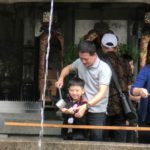


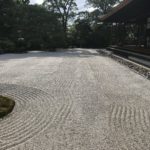


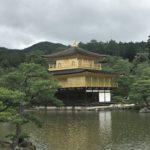



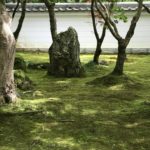




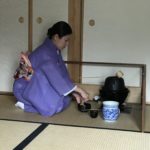
wonderful to see and get your description of the sites you are getting to – what a trip – what a pair.
will try to follow more regularly. please stay safe.
Don
Thanks Don!
We are at the “Top End” for 6 days.
Congrats to the graduates and their proud parents!